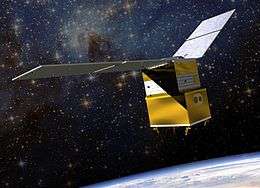Green Propellant Infusion Mission
 Artist's rendering of GPIM on Earth orbit | |
| Mission type | Technology demonstrator |
|---|---|
| Operator | NASA |
| Mission duration | Two months [1] |
| Spacecraft properties | |
| Bus | BCP-100 |
| Manufacturer | Ball Aerospace |
| BOL mass | ≤180 kg (400 lb) |
| Start of mission | |
| Launch date | November 2018[2] |
| Rocket | Falcon Heavy |
| Launch site | LC-39A, Kennedy Space Center |
| Contractor | SpaceX |
The Green Propellant Infusion Mission (GPIM) is a planned NASA technology demonstrator project that will test a less toxic and higher performance/efficiency chemical propellant for next-generation launch vehicles and spacecraft.[1][3][4] When compared to the present high-thrust and high-performance industry standard for orbital maneuvering systems, which for decades, have exclusively been reliant upon toxic hydrazine based propellant formulations, the "greener" hydroxylammonium nitrate(HAN) monopropellant may offer many advantages for future satellites, including longer mission durations, additional maneuverability, increased payload space and simplified launch processing.[1][3][5] The GPIM is managed by NASA's Marshall Space Flight Center in Huntsville, Alabama, and is part of NASA's Technology Demonstration Mission Program within the Space Technology Mission Directorate.
The Green Propellant Infusion Mission is scheduled to launch aboard a SpaceX Falcon Heavy rocket in 2018, on a test mission called Space Test Program 2 (STP-2). [6] The cost of the program is projected to be approximately $45 million.[7]
Development
Propellant
The propellant for this mission is hydroxylammonium nitrate (NH3OHNO3) fuel/oxidizer blend, also known as AF-M315E.[4] Preliminary data indicates that it offers nearly 50% higher performance for a given propellant tank volume compared to a conventional monopropellant hydrazine system.[1][4][8] The Green Propellant Infusion Mission seeks to improve overall propellant efficiency while reducing the toxic handling concerns associated with the highly toxic propellant hydrazine.[3][9] The new propellant is an energetic ionic liquid. Ionic liquids are salt compounds in a liquid form whose molecules have either a positive or negative charge, which bonds them together more tightly and makes the liquid more stable.[10]
This new propellant is also expected to be significantly less harmful to the environment.[4] It is called a "green" fuel because when combusted, AF-M315E transforms into nontoxic gasses.[10] The AF-M315E propellant, nozzles and valves are being developed by the Air Force Research Laboratory (AFRL), Aerojet Rocketdyne, and Glenn Research Center, with additional mission support from the U.S. Air Force Space and Missile Systems Center and NASA's Kennedy Space Center.
Satellite
The GPIM system will fly aboard the small Ball Configurable Platform 100 (BCP 100) spacecraft bus.[4][9] Aerojet Rocketdyne is responsible for the development of the propulsion system payload, and the technology demonstration mission will employ an Aerojet-developed advanced monopropellant payload module as the sole means of on-board propulsion.[8]
Scientific payload
The Defense Department's Space Experiments Review board has selected three payloads to be hosted aboard GPIM:
- an Air Force Academy instrument to characterize Earth's ionosphere and thermosphere.
- a Naval Research Laboratory instrument to measure plasma densities and temperatures.
- an Air Force Institute of Technology instrument that will test space collision avoidance measures.[11]
Applications
Once proven in flight, the project will present AF-M315E and compatible tanks, valves and thrusters to NASA and the commercial spaceflight industry as "a viable, effective solution for future green propellant-based mission applications."[5][9] According to NASA, the new propellant will be an enabling technology for commercial spaceports operating across the U.S. "permitting safer, faster and much less costly launch vehicle and spacecraft fuel loading operations."[3] The combined benefits of low toxicity and easy open-container handling will shorten ground processing time from weeks to days, simplifying the launching of satellites.[3] The new AF-M315E fuel is 45% denser than hydrazine,[12] meaning more of it can be stored in containers of the same volume. It also has a lower freezing point, requiring less spacecraft power to maintain its temperature.[5]
In addition to its use on lighter satellites and rockets, the fuel's exceptional volumetric storage properties is also being assessed for military uses such as missile launches.[4]
See also
References
- 1 2 3 4 "The Green Propellant Infusion Mission (GPIM)" (PDF). Ball Aerospace & Technologies Corp. March 2013. Archived from the original (PDF) on September 23, 2015. Retrieved 2014-02-26.
- ↑ Pietrobon, Steven (8 June 2018). "United States Military Manifest". Retrieved 11 June 2018.
- 1 2 3 4 5 "About Green Propellant Infusion Mission (GPIM)". NASA. 2014. Retrieved 2014-02-26.
- 1 2 3 4 5 6 "Green Propellant Infusion Mission (GPIM)". Ball Aerospace. 2014. Retrieved 2014-02-26.
- 1 2 3 "Green Propellant Infusion Mission Project" (PDF). NASA. July 2013. Retrieved 2014-02-26.
- ↑ SpaceX to conduct second (or third) Falcon Heavy launch on April 30, 2018
- ↑ Casey, Tina (19 July 2013). "NASA Sets Its Sights On $45 Million Green Fuel Mission". Clean Technica. Retrieved 2014-02-27.
- 1 2 Spores, Ronald A.; Robert Masse, Scott Kimbrel, Chris McLean (15–17 July 2013), "GPIM AF-M315E Propulsion System" (PDF), 49th AIAA/ASME/SAE/ASEE Joint Propulsion Conference & Exhibit (PDF)
|format=requires|url=(help), San Jose, California, USA - 1 2 3 Mohon, Lee (2013). "Technology Demonstration Missions: Green Propellant Infusion Mission (GPIM)". NASA. Retrieved 2014-02-27.
- 1 2 Scharr, Jillian (16 May 2013). "New Rocket Fuel Helps NASA 'Go Green'". Tech News Daily. Retrieved 2015-02-10.
- ↑ NASA Green Propellant Mission To Host Three Pentagon Experiments. Space News. Mike Gruss. October 17, 2014.
- ↑ David, Leonard (April 13, 2016). "Spacecraft Powered by 'Green' Propellant to Launch in 2017". Space. Retrieved 2016-04-15.
External links
- Spores, Ronald A.; Robert Masse, Scott Kimbrel, Chris McLean (15–17 July 2013), "GPIM AF-M315E Propulsion System", 49th AIAA/ASME/SAE/ASEE Joint Propulsion Conference & Exhibit (PDF), San Jose, California, USA


